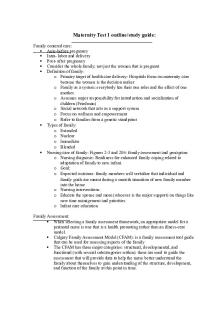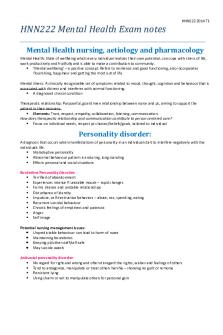Chapter 4 - Summary Family Health Care Nursing: Theory Practice and Research PDF

| Title | Chapter 4 - Summary Family Health Care Nursing: Theory Practice and Research |
|---|---|
| Course | Family Health |
| Institution | University of Regina |
| Pages | 4 |
| File Size | 111.4 KB |
| File Type | |
| Total Downloads | 4 |
| Total Views | 123 |
Summary
Summary of Chapter 4 reading, including key concepts and key terms. This is an essential chapter for the mandatory paper and helpful in preparation for the exams....
Description
Chapter 4 Summary Family Nursing Assessment and Intervention Family health care nursing uses assessment, clinical judgment, creativity, critical thinking, evaluation, and reflective processes. This complexity is necessary to provide adequate care for increasingly diverse family populations. Building on what students know about using the nursing process for an individual client’s care, Chapter 4 provides an overview of family nursing assessment models and instruments that nurses can use when working with families as clients. The models described in this chapter include the family assessment and intervention model (Berkey-Mischke & Hanson, 1991), the Friedman Family Assessment Theory and Model (Friedman et al., 2003), and the Calgary Family Assessment Model (Wright & Leahey, 2013). Approximately 1,000 family-focused instruments and tools exist for the nurse to select from, and selection of an appropriate instrument for the family situation can be complex. This chapter features the following tools and instruments for use in designing family health care according to the nursing process: 1. The Family Systems Stressor-Strength Inventory (FS3I) (Berkey-Mischke & Hanson, 1991; Hanson, 2001; Kaakinen, Hanson, & Denham, 2010) 2. The family genogram and ecomap 3. The Family Reasoning Web (Tabacco & Kaakinen, 2010) 4. North American Nurses Diagnosis Association (NANDA) classification system (2007) 5. Beliefs and Illness Model (Wright & Bell, 2009) 6. Patient/Parent Information and Involvement Assessment Tool (PIINT; Sobo, 2001)Note: The Handbook of Family Measurement Techniques (Touliatos, Perlmutter, & Strauss, 2001) can augment this list of tools and is useful in identifying family variables. Chapter 4 assists students in comprehending the variety and complexity of variables that affect the selection of tools for family assessment, intervention, and evaluation. It helps students differentiate between tools for screening and assessment, testing or measurement and outcome parameters, and quantitative versus qualitative data collection methods. This chapter illuminates the value of using both the traditional nursing process and newer nursing process models, emphasizing the creativity involved in family health care nursing. A case study that uses the steps of the nursing process as well as provides various models and tools for further understanding is included.
Critical Concepts
Families are complex social systems with which nurses interact in many ways and in many contexts; the use of a logical systematic family nursing assessment approach is important. In the context of family nursing, the creative nurse thinker must be aware of possibilities, be able to recognize the new and the unusual, be able to decipher unique and complex situations, and be inventive in designing an approach to family care. Nurses determine through which theoretical and practice lens(es) to analyze the family event. Knowledge about family structures, functions, and processes informs nurses in their efforts to optimize and provide individualized nursing care, tailored to the uniqueness of every family system. Nurses begin family assessment from the moment of contact or referral. Family stories are narratives that nurses construct in framing, contextualizing, educating, communicating, and providing interpretations of their family clients’ needs as they exercise clinical judgment in their work. Interacting with families as clients requires knowledge of family assessment and intervention The family genogram and ecomap are both assessment-data-gathering instruments. The therapeutic interaction that occurs with the family while diagramming a genogram or ecomap is itself a powerful intervention. Families’ beliefs about health and illness, about nurses and other health care providers, and about themselves are essential for nurses to explore to craft effective approaches to family interventions and promote health literacy. Families determine the level of nurses’ involvement in their health and illness journeys, and nurses seek to tailor their work and approach accordingly. Nurses and families who work together and build on family strengths are in the best position to determine and prioritize specific family needs; develop realistic outcomes; and design, evaluate, and modify a plan of action that has a high probability of being implemented by the family. The final step in working with families should always be for nurses to engage in critical, creative, and concurrent reflection about the family, their work with the family, and professional self-reflection of their practice.
Chapter 4 Key Terms
Assessment: A continuously evolving process of data collection in which the nurse, drawing on the past and the present, is able to predict or plan the future. Client story: The problem the family is currently experiencing. Data: Pieces of information collected in a study to answer research questions. Desired outcomes: To determine whether the outcome is being achieved, the nurse identifies tests or measures that will provide information about the resolution of the problems. Nurses make decisions about which nursing interventions are most appropriate for the family. Ecomap: A diagrammatical assessment procedure (drawing) that portrays the family’s relationships to other systems in the community in which the family is imbedded, that is, work, school, and church, among others. Family-centered care (FCC): According to the Institute for Patient- and FamilyCentered Care (IPFCC, 2013), the core principles are respect and dignity, information sharing, participation, and collaboration. The goal of FCC is to increase the mutual benefit of health care provision for all parties, with a focus on improving the satisfaction and outcome of health care for families (IPFCC, 2013). Family Reasoning Web: The process of gathering data by asking about organizational categories and placing information into meaningful groups so that nurses can identify relationships and make accurate family diagnoses. Genogram: A format for diagramming a family that illustrates family structure. Other information that is included on the drawing is family constellation, health history, and family relationships. Judgment: The decision the nurse makes to evaluate client progress toward the desired outcomes. Nursing diagnosis: A clinical judgment about individual family or a community response to actual and potential health problems or life processes. Nursing diagnoses provide the basis for selection of nursing interventions to achieve outcomes for which the nurse is accountable. Although NANDA is the most global nursing classification system, not all family situations will match that in existences that are specific to family. Nurses
are encouraged to create a family nursing diagnosis that captures the essence of a family issue or problem. Nursing process: An orderly, systematic manner of determining the client’s problems, making plans to solve them, initiating the plan or assigning others to implement it, and evaluating the extent to which the plan was effective in resolving the problems identified. Prevention: (1) Primary: focuses on preventing the occurrence of health problems; (2) secondary: designed to identify and treat health problems early; (3) tertiary: aimed at correcting health problems and preventing further deterioration. Reflection: A strategy nurses use to review and learn from clients to enhance and expand their practice base. Shared decision making: The process of building a therapeutic relationship to allow shared decision making with family members and health care providers to develop an effective action plan or care plan....
Similar Free PDFs

Sample Family Nursing Care Plan
- 3 Pages
Popular Institutions
- Tinajero National High School - Annex
- Politeknik Caltex Riau
- Yokohama City University
- SGT University
- University of Al-Qadisiyah
- Divine Word College of Vigan
- Techniek College Rotterdam
- Universidade de Santiago
- Universiti Teknologi MARA Cawangan Johor Kampus Pasir Gudang
- Poltekkes Kemenkes Yogyakarta
- Baguio City National High School
- Colegio san marcos
- preparatoria uno
- Centro de Bachillerato Tecnológico Industrial y de Servicios No. 107
- Dalian Maritime University
- Quang Trung Secondary School
- Colegio Tecnológico en Informática
- Corporación Regional de Educación Superior
- Grupo CEDVA
- Dar Al Uloom University
- Centro de Estudios Preuniversitarios de la Universidad Nacional de Ingeniería
- 上智大学
- Aakash International School, Nuna Majara
- San Felipe Neri Catholic School
- Kang Chiao International School - New Taipei City
- Misamis Occidental National High School
- Institución Educativa Escuela Normal Juan Ladrilleros
- Kolehiyo ng Pantukan
- Batanes State College
- Instituto Continental
- Sekolah Menengah Kejuruan Kesehatan Kaltara (Tarakan)
- Colegio de La Inmaculada Concepcion - Cebu














